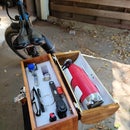Introduction: Build a Greenhouse With Solar Powered Ventilation
I live in Sunset climate zone 17 (San Francisco), so their were a lot of things I'd like to grow, but could not owing to the climate. My basil was scrawny, my eggplant shriveled... I was lucky to get 2 or 3 tiny tomatoes per plant. I always wanted a greenhouse but all the prefab ones that seemed large enough were beyond my price range. Then one day perusing the Harbor Freight flyer I found a 10' x 12' greenhouse for less than a thousand dollars. I spent some time googling reviews of said greenhouse and out of the box it seemed awful. One person described it as a box kite as it merrily sailed out of her garden one day ala wizard of oz. But then I found more instructions to re-enforce the structure. So late one hot August afternoon I drove north the closest HF store. I walked out with the greenhouse for less than $600.00 (using a common 20% off coupon). I choose the sunniest part of the yard with a southern exposure to site the greenhouse. From breaking ground to finished greenhouse it took about 20 man days.
Step 1: Tools and Materials Required for the Basic Construction
Tools
Skillsaw
Clamps (helpful to hold greenhouse parts during assembly)
Framing square, tape measure, level
Drill and drill bits
Power screwdriver
wrenches
vice (to flatten the emt bracing)
hand saw
Materials
10x12 greenhouse kit from harbor freight
Extreme weather foil tape (to seal the ends of all the polycarbonate panels)
12 tubes of clear Alex plus latex caulk (to glaze and seal the plastic greenhouse panels)
200 Hex Washer Head, Hex Drive, No. 10, 1 Inch Long, No. 3 Point Size, Self Drilling Screws and 200 #10 fender washers. to fasten the plastic panels to the greenhouse frame.
As needed depending on your configuration, 1/4 inch x 1.5 inch T bolts for adding interior gussets (I made mine by grinding the head down on a regular 1/4 20 tpi x 1.5 inch cap screws)
Pressure treated lumber 2 - 2x12x12', 2 - 2x12x10', 4 - 4x4x8'
1/2 x 7.5" galvanized machine bolts, nuts and washers
3" deck screws
8 sacks of concrete to set the posts
6 - 20 in. x 13 in. Gray Heavy Duty Shelf Brackets (cross bracing)
3 - 3/4"x10' steel emt tubing (cross bracing)
Optional materials
decomposed granite for flooring
Wood, screws and liner for hydroponic water culture trays.
Pump for recirculating water culture hydroponic system.
Sink and stand
Solar panels and 12 volt fan
Step 2: General Foundation and Construction Notes
For my particular installation on a hillside, I also Incorporated a retaining wall and a deck. the foundation for the greenhouse consists of pressure treated 2X12s on edge tied to the retaining wall on one side and pressure treated 4x4x8' posts set in concrete 3' in the ground on the other side to form a 10'x12' box in the ground with one 2x12 in the center running crosswise. on top of the 10'x12' box I attached pressure treated 2x6 flat-wise. on top of the 2x6 I set the steel base that comes with the greenhouse that the instructions say to "bury in the ground. I then proceeded with the very good instructions provided with the greenhouse. Until I reached the Polycarbonate panel installation part. There is an excellent instructable here for building the Harbor Freight 6x8 greenhouse, The same principles apply to the 10x12 I built.
Step 3: Polycarbonate Plastic Panel Instalation
I read a lot of reviews that talked about panels flying off and landing miles away.first I sealed the ends of all the panels with the best aluminum tape I could find I used Extreme weather aluminum tape, this prevents algae and gunk from getting in and messing up the panels. When installing the panels, I bedded all of mine in clear Alex plus caulk and used the funky clips provided to hold the panels in place until the caulking cured, then I used hex head self tapping screws with fender washers (bedded in Alex Plus caulk) to screw the panels to the aluminum cross pieces (I made 3/4 wide x 1/4 thick wood furring strips to put behind the Polycarbonate panels in some parts of the greenhouse. I have not lost a single panel so far.
Step 4: Roof Vent/windows
Save the hinge pieces that slide into the peak of the roof and throw the rest away. The windows are designed to leak. Go out and get 4 oversize pieces of 1/4" Plexiglas about 2" larger than the window/vent opening. make a 1/2" spacer out of hardwood and attach the plexi to the hinges using the spacer . I used automatic openers on the window/vents to prevent overheating (Univent Automatic Vent Opener Standard - Lifts 15 Lbs).
Step 5: Additional Bracing
I used the shelf brackets and EMT tubing to provide 3 cross braces. T bolts fasten the brackets to the greenhouse. I also used some scrap aluminum to add backing at each gable end. I used angle brackets to attach the hydroponic trays to the walls of the greenhouse, this has the added benefit of re-enforcing the greenhouse walls. The T bolts come in very handy for attaching brackets wherever you want after construction is completed. Also be sure your steel base is securely fastened to your foundation.
Step 6: Solar Powered Ventilation
Simple concept, solar panels are directly connected to fan, sun comes out fan goes on.
I added 2 sets of solar panels (shown in the first picture) directly connected to a 12 volt fan for ventilation. the fan sits over a box I framed in the floor with 2x12 that is open to the outside. I bolted 2 4x4x12' posts to the retaining wall next to the greenhouse and attached the solar panels to them.
My theory behind it is the outside air may be cooler in that low shady spot. Fan is an Endless Breeze from Amazon. Solar panels are from Harbor Freight, but with a little research you can buy better panels elsewhere.
Step 7: Hydroponics
Their is a vast number of instrutables on this site that go into a lot of detail on the subject of hydroponics. So I'm just going to touch on a few details of my system and at the middle of the page a few details that don't get mentioned enough.
The hydroponic system is a recirculating shallow water culture system, based on airstones in the reservoir, the beds are 5.5 inches deep with a water level of about 3 inches. I used a 275 gallon IBC tote for a reservoir, the large capacity reservoir provides a buffer to a lot of hydroponic problems, PH and temperature swings for example I don't change the water during the season I just add to it and watch the PPM nutrient level, pump 620 GPM Harbor Freight, Liner EDPM pond liner 40 mil, drains between beds are 2" ABS bulkhead fittings - pipe nipples cut from 2" ABS pipe set the water level - nipples are sealed with lanocote (Lanolin) to facilitate removal and replacement, with mini towers under each between bed drain. Netpots are 3", grow media is Hydroton expanded clay. I cut the netpot holes, in the redwood tops, with a hole saw and saved the rounds to make plugs for unused holes. I use JR Peters nutrients. I've had great success with Cantaloupe, Basil, Eggplant, Tomatoes and Watercress. Seeds are started in a little bit of rockwool (available from http://mcmaster.com).
One thing I will be doing is insulating the reservoir. to keep it from getting too cold. The pump and airstones provides some heat.
Hydroponic Important points
Filter your reservoir water when you fill. I use an RV charcoal filter. I'm (Camco 40043 TastePURE Water Filter with Flexible Hose Protector from Amazon).
Watch your PH with litmus paper. This affects nutrient uptake. anything lower than 5.6 will result in lockout. Shoot for a PH of 5.7 to 6.2.
Watch your water temperature. the ideal temp is 68 F. but a range from 65 to 75 F will work, mine often runs at 64F I can get 11 ppm dissolved oxygen at that temp .
I use a simple PPM meter to measure my nutrient level. The high dissolved oxygen level in my system allows me to keep the PPM under 600. Less oxygen will require more nutrients.
Watch your dissolved oxygen. Make sure your plants get plenty of oxygen. any time water is splashing, bubbling running it's absorbing oxygen. High oxygen levels promote aerobic bacteria which protects your system from all kinds of nasty things My airstones keeps mine at 9 mg/l according to my oxygen test kit (Hach 146900 Dissolved Oxygen Test Kit)
One exception to the "needs lots of oxygen" rule is lettuce... It would probably grow in orange juice.
Step 8: After 4 Years
The polycarbonate panels have no UV protection. the walls are still clear for the most part but the roof has yellowed and will need to be replaced in 3 or 4 years. the rest of the greenhouse has been great and problem free. I don't grow anything in soil in the greenhouse anymore as I've have huge whitefly infestations in the past. I'm pretty sure the wet soil is the breeding ground for my whitefly's.
Step 9:
After 6 years, here's a short video update

Second Prize in the
Renewable Energy Contest

Participated in the
Outdoor Structures Contest













